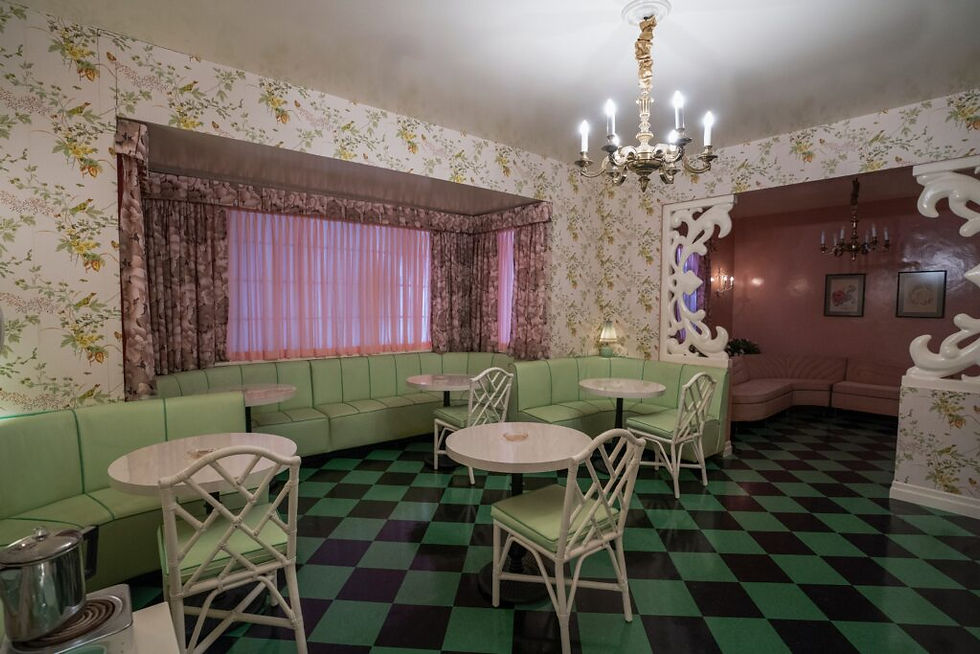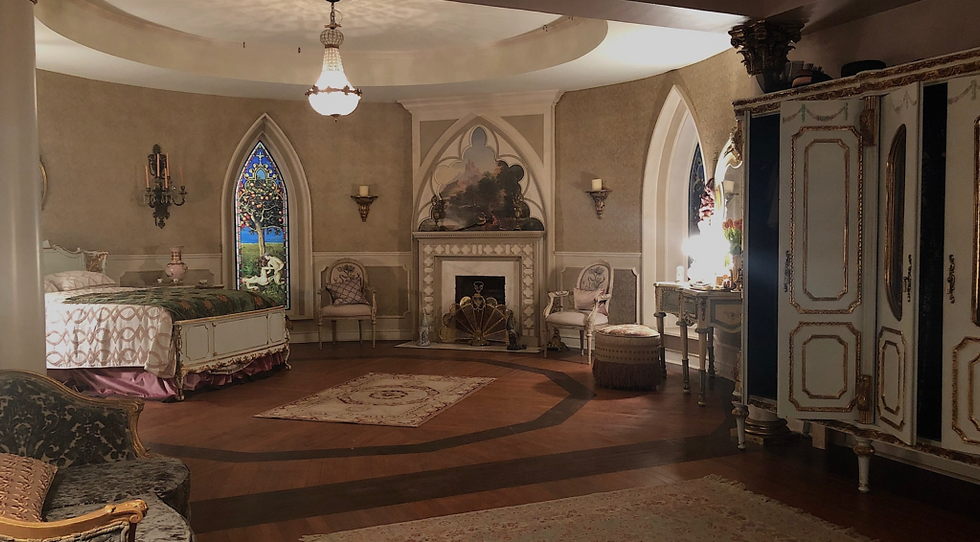Five New Period TV Shows Sure to Please Interior Designers
- PIMM Wix Team

- Mar 26, 2021
- 5 min read
Last September, we published our list of “15 FILMS FOR MODERN ARCHITECTURE AND DESIGN LOVERS,” followed by “15 TV SHOWS FOR ARCHITECTURE AND DESIGN LOVERS,” both of which elicited interest from our readers. If you’ve plowed through all thirty of our recommendations (it’s possible, considering how much time many of us are staying home), or did not find any titles on the past lists that struck your fancy, we are sharing four more suggestions.
This time, we’re focused on time traveling interiors; meaning the series that caught our eye for their stylish, accurate and story-telling sets. Five recent TV shows have succeeded in recreating periods from the past, including the 1940s, 1950s, 1960s… and the 18th century. In this article, we’re including insights from the production designers on how turned sets back in time.
Keep reading to find out which show is the best match for you – who knows, transporting to another era might even inspire one of your current projects!
Ratched (2020)
Where to Watch: Netflix
Genre: Horror
Ryan Murphy’s (“American Horror Story,” “Glee”) latest series, a prequel to “One Flew Over The Cuckoo’s Nest,” may take place in a 1940s asylum, but don’t let that fool you into thinking the interiors won’t be beautiful. The show follows the villain of the original movie taking her post as a sadistic nurse at a mental facility, but creator Ryan Murphy wanted the frightening location to look more like a resort than a clinical building. “Sometimes it’s really warranted to do a very frightening-looking set design for a very frightening story,” said the show’s production designer, Judy Becker, “But the horror in Ratched is a little over the top, so you can balance it with all this beauty and that dichotomy works really well.” If you aren’t afraid of some good ‘old-fashioned’ horror, queue up “Ratched” for a richly imagined version of the famed Lucia State Hospital.

“Ratched” set (photo from Netflix)

“Ratched” set (photo from Netflix)

“Ratched” set (photo from Netflix)
For All Mankind (2019)
Where to Watch: Apple TV Plus
Genre: Drama
One of our founder, Wayne’s, favorite new shows is Apple TV’s “For All Mankind.” The series rewrites history as if Russia won the space race and landed on the moon before the United States, and features scenes from inside NASA control rooms, the astronauts’ homes, a local bar, and a moon base, all created by Dianna Freas and her team of thirteen set decorators. Because of the wide range of interiors, (mid-century homes and moon landing bases, of course, differ in decor) research was key. “We used heavy visual research and we were able to match the [control room] consoles from NASA.” Frejas said, “One of the most challenging things to find were the chairs for that room… we needed 40 and they were all created from scratch.” In terms of the astronauts’ homes, Freas and her team had direct references; LIFE Magazine did a story on real-life astronauts’ homes, and the sets reflect those images as closely as possible. Even for seemingly small details, historical research and anthropology was required. “The writers were very specific about the types of televisions they wanted,” Freas said of the prop selection, “[One family in the show] are more conservative, so they got a console, and [another family] are more mid-century—so they have a newer looking television.” For another of the major set pieces, the moon base, the creators did not want the show to come across as ‘Star Trek’-like, and were careful to design the base in a way that remained realistic for the time. During the process, Frejas and her team received input from her husband, Dan Bishop, the production designer on “For All Mankind,” and another iconic period show, “Mad Men.” For this show set in a somewhat recent reality, historical references, analyzing scripts, and digging deep into research results in a hit show noted by critics for its period accuracy.

“For All Mankind” set (photo from Apple)

“For All Mankind” set (photo from Apple)

“For All Mankind” set (photo from Apple)
The Marvelous Mrs. Maisel (2017)
Where to Watch: Amazon Prime
Genre: Drama, Comedy
This beloved show starring Rachel Brosnahan is known for its story of a 1950s housewife pursuing a career in comedy, but one of the most exciting elements of the show is its ode to midcentury Manhattan in all of its pastel, tile, and floral-print glory. Bill Groom, the show’s lauded production designer, revealed a trick he uses to make users feel as though they are traveling back in time; “There’s all the stuff that only existed, in this case, in the 1950s that doesn’t exist anymore, then there’s all the stuff we have now that didn’t exist then, then in the middle is all this stuff that we have now that they also had then, so that was the place I felt the audience could feel comfortable. You just have those one or two items, usually technology, that really locks a space into the time.” For “Maisel,” crafting an accurate 1950s set did not mean that every piece had to be a vintage find or recreation, rather, adding key elements, like a vintage Smeg fridge, or a retro TV clue the viewer in on when the story takes place.

“The Marvelous Mrs. Maisel” set (photo from Amazon)

“The Marvelous Mrs. Maisel” set (photo from Amazon)

“The Marvelous Mrs. Maisel” set (photo from Amazon)
The Great (2020)
Where to Watch: Hulu
Genre: Comedy
Hulu’s Elle Fanning-led story about Catherine the Great is a self-described “anti-historical ride through 18th-century Russia,” but the show’s modern, comedic take on the Russian oligarchs does not take set-design as lightly as it takes historical fact. To cement the location and period visually, Francesca di Mottola, the series’ production designer, turned UK soundstages into a Russian palace. Details from the set required the help of a calligraphy artist, “all the gold paint supplies in the U.K,” and prints of authentic Russian documents. The palace is not inspired solely by Russian design, but rather an amalgamation of royal references throughout history, with one of the goals being to keep each room (or, soundstage), different from the next. “We wanted it to feel like the people didn’t really know each other,” said Mottola, “the variety of styles enhanced that notion.” While 18th century Russia is not always considered ‘bingeable’, “The Great” is a hilarious retelling of a legendary historical figure, and its updated dialogue and grandiose interiors make it hard to look away.

“The Great” set (photo from Hulu)

“The Great” set (photo from Hulu)

“The Great” set (photo from Hulu)
Lovecraft Country (2020)
Where to Watch: HBO
Genre: Science Fiction
One of the most talked-about new shows of 2020 was “Lovecraft Country,” about a Black couple in the 1950s who travels through segregated America. The issues the couple faces are not only related to racial inequality, but science fiction monsters from HP Lovecraft’s famous books. Color played a major role in the set-building and mood-setting of the story. Production designer Kalina Ivanov “painted the bedroom a deep pomegranate red to represent a non-traditional, jazz-loving, book-reading family,” and “purposefully kept the darkest palette for [a female character’s] Chicago mansion, since her character was full of secrets and mystery.” A segregated store was decorated with black and white tiles as a visual representation of the racial climate at the time. For a scene set in a dangerous lodge, Ivanov designed a set with “very sharp edges, bringing a sense of menace and danger to the world around our protagonists,” while keeping the setting period-specific with architectural nods to oil baron mansions with Tudor-esque elements. The show features an expanse of locations, as the characters travel across the country, which was an impressive undertaking for production. With the help of VFX experts, Ivanov and her team managed to create a stunning show that visually combines science fiction with real-life America.

“Lovecraft Country” set (photo from HBO)

“Lovecraft Country” set (photo from HBO)

“Lovecraft Country” set (photo from HBO)



Comments